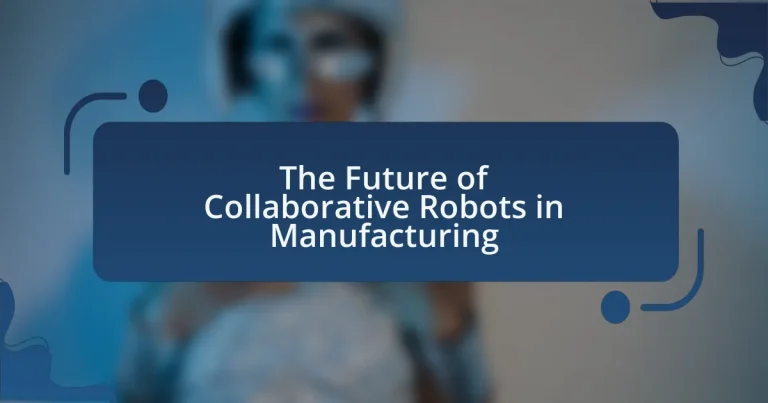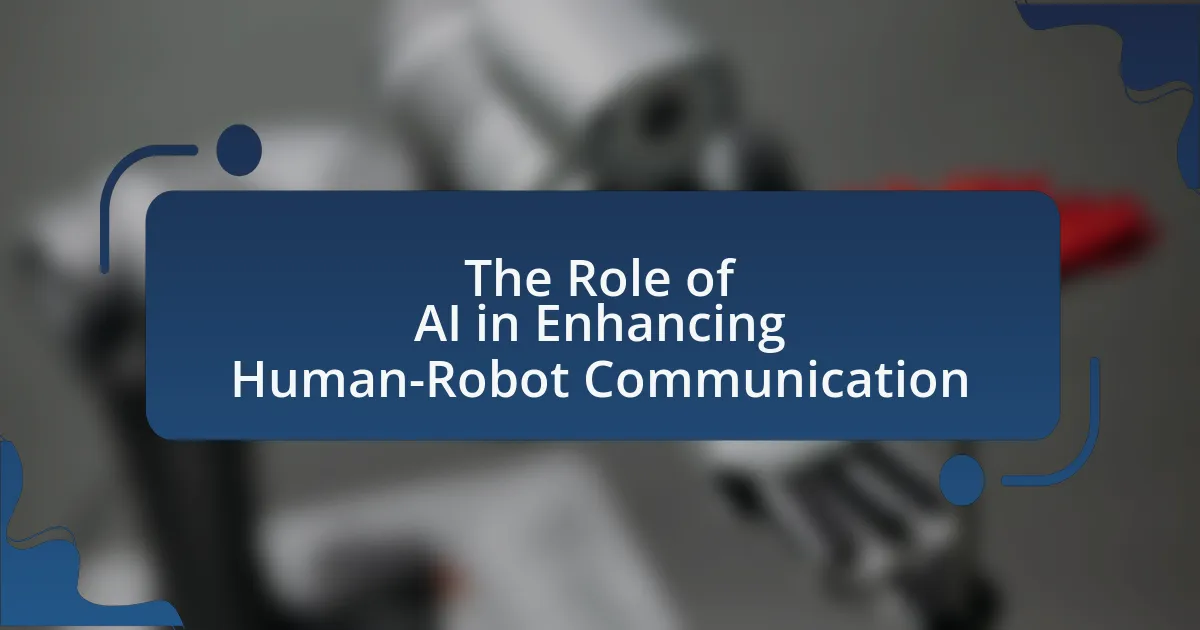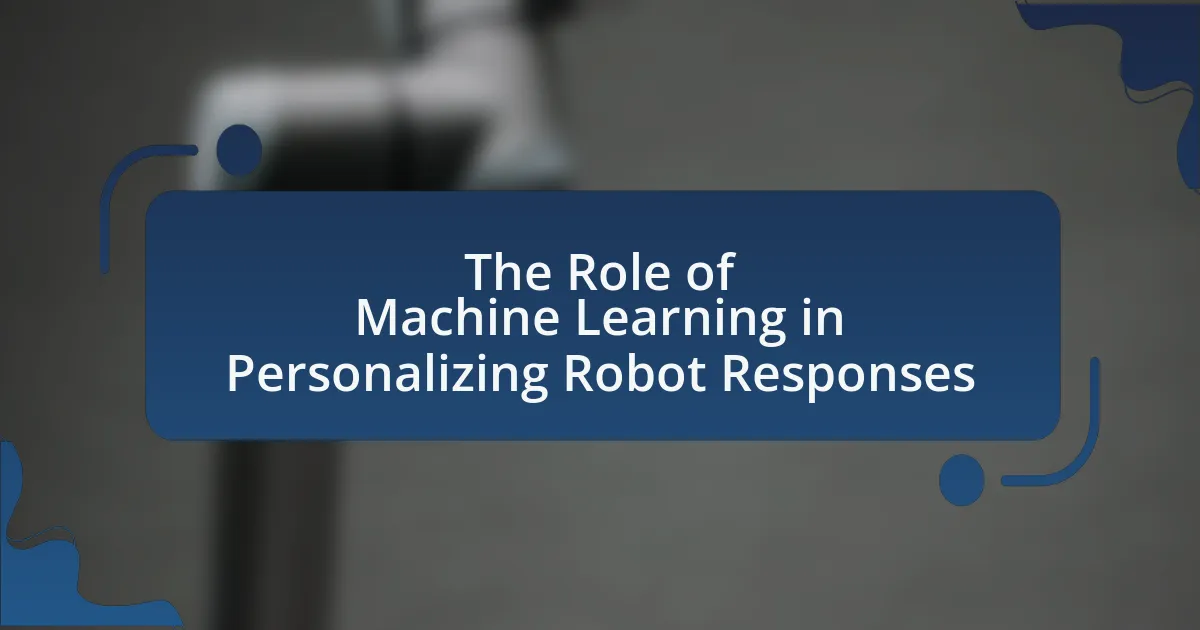Collaborative robots, or cobots, are robotic systems designed to work alongside human operators in manufacturing environments, enhancing productivity, safety, and flexibility. This article explores the role of cobots in various industries, their key features, and how they differ from traditional industrial robots. It also examines the current state and future trends of collaborative robots, including technological advancements, challenges in implementation, and the impact on human workers. Additionally, the article highlights best practices for integrating cobots into workflows and the potential for sustainable manufacturing practices.
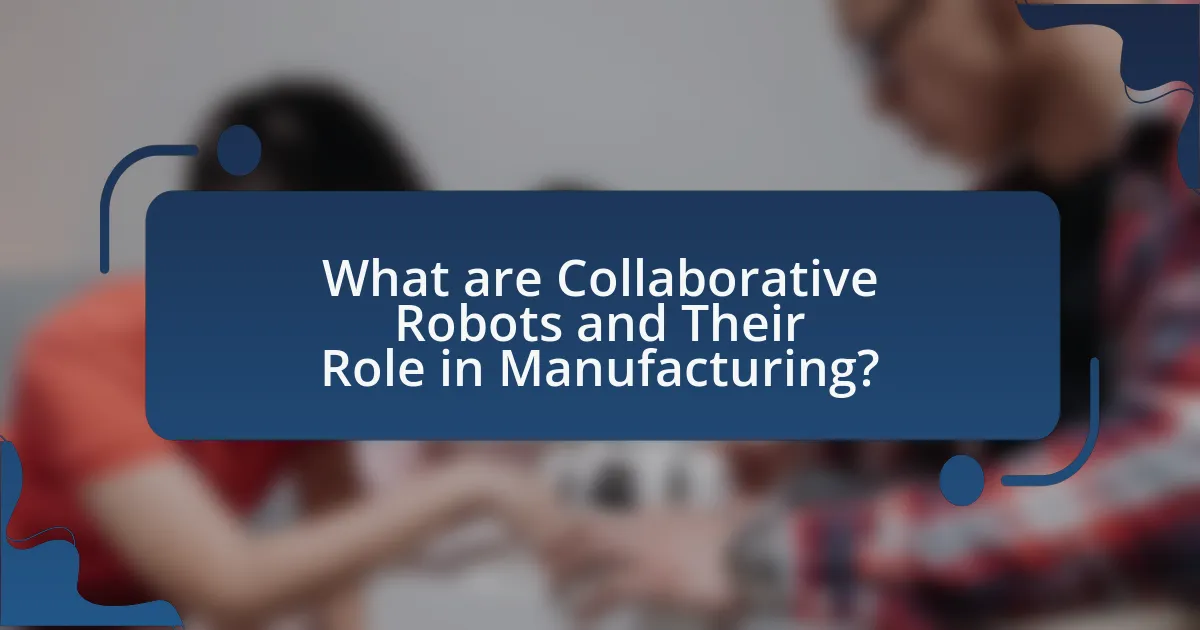
What are Collaborative Robots and Their Role in Manufacturing?
Collaborative robots, or cobots, are robotic systems designed to work alongside human operators in a shared workspace. Their role in manufacturing includes enhancing productivity, improving safety, and increasing flexibility in production processes. Cobots are equipped with advanced sensors and AI, allowing them to perform tasks such as assembly, welding, and packaging while adapting to human movements and ensuring safe interaction. According to a report by the International Federation of Robotics, the market for collaborative robots is expected to grow significantly, reflecting their increasing adoption in various manufacturing sectors. This growth is driven by the need for automation that complements human labor rather than replacing it, thereby optimizing operational efficiency and reducing costs.
How do collaborative robots differ from traditional industrial robots?
Collaborative robots, or cobots, differ from traditional industrial robots primarily in their design and intended interaction with human workers. Cobots are engineered to work alongside humans safely, featuring advanced sensors and safety mechanisms that allow them to operate in close proximity without the need for safety cages, while traditional industrial robots typically require isolation due to their speed and strength, posing potential hazards to human operators. This distinction is supported by the International Federation of Robotics, which notes that cobots are designed for flexibility and ease of use, enabling non-expert users to program and operate them, whereas traditional robots often necessitate specialized programming skills and extensive setup.
What are the key features of collaborative robots?
Collaborative robots, or cobots, are designed to work alongside humans, enhancing productivity and safety in manufacturing environments. Key features include safety mechanisms such as force limiters that prevent injury during interaction with human workers, enabling close collaboration without the need for safety cages. Additionally, cobots are equipped with advanced sensors and vision systems that allow them to perceive their surroundings and adapt to dynamic environments. Their ease of programming, often through intuitive interfaces, allows operators with minimal technical expertise to set them up quickly for various tasks. Furthermore, cobots are typically lightweight and portable, facilitating easy reconfiguration and deployment across different workstations. These features collectively contribute to increased efficiency and flexibility in manufacturing processes.
Why are collaborative robots considered safer for human workers?
Collaborative robots are considered safer for human workers because they are designed with advanced safety features that allow them to operate alongside humans without the need for safety cages. These robots utilize sensors, cameras, and force-limiting technology to detect human presence and adjust their movements accordingly, minimizing the risk of injury. For instance, studies have shown that collaborative robots can reduce workplace accidents by up to 85% when integrated into manufacturing environments, demonstrating their effectiveness in enhancing safety.
What industries are currently utilizing collaborative robots?
The industries currently utilizing collaborative robots include manufacturing, healthcare, logistics, and agriculture. In manufacturing, collaborative robots assist in assembly, quality control, and packaging, enhancing productivity and safety. In healthcare, they support tasks such as surgery assistance and patient care, improving precision and efficiency. The logistics sector employs collaborative robots for sorting, packing, and inventory management, streamlining operations. In agriculture, these robots aid in planting, harvesting, and monitoring crops, contributing to increased yield and reduced labor costs. The widespread adoption of collaborative robots across these industries demonstrates their versatility and effectiveness in enhancing operational efficiency.
How do collaborative robots enhance productivity in manufacturing?
Collaborative robots enhance productivity in manufacturing by automating repetitive tasks while working alongside human operators. These robots increase efficiency by performing tasks such as assembly, welding, and packaging at a consistent speed and precision, which reduces cycle times and minimizes errors. For instance, a study by the International Federation of Robotics reported that the integration of collaborative robots can lead to productivity increases of up to 30% in manufacturing environments. Additionally, their ability to operate safely in close proximity to humans allows for a more flexible workforce, enabling manufacturers to adapt quickly to changing production demands without significant downtime.
What specific tasks can collaborative robots perform in various sectors?
Collaborative robots, or cobots, can perform a variety of specific tasks across different sectors, including manufacturing, healthcare, logistics, and agriculture. In manufacturing, cobots are utilized for assembly, welding, painting, and quality inspection, enhancing productivity and precision. In healthcare, they assist in tasks such as medication dispensing, patient monitoring, and surgical assistance, improving efficiency and safety. In logistics, cobots handle material transport, sorting, and packaging, streamlining operations and reducing labor costs. In agriculture, they are employed for planting, harvesting, and monitoring crops, increasing yield and reducing manual labor. These applications demonstrate the versatility and effectiveness of collaborative robots in enhancing operational efficiency across multiple industries.
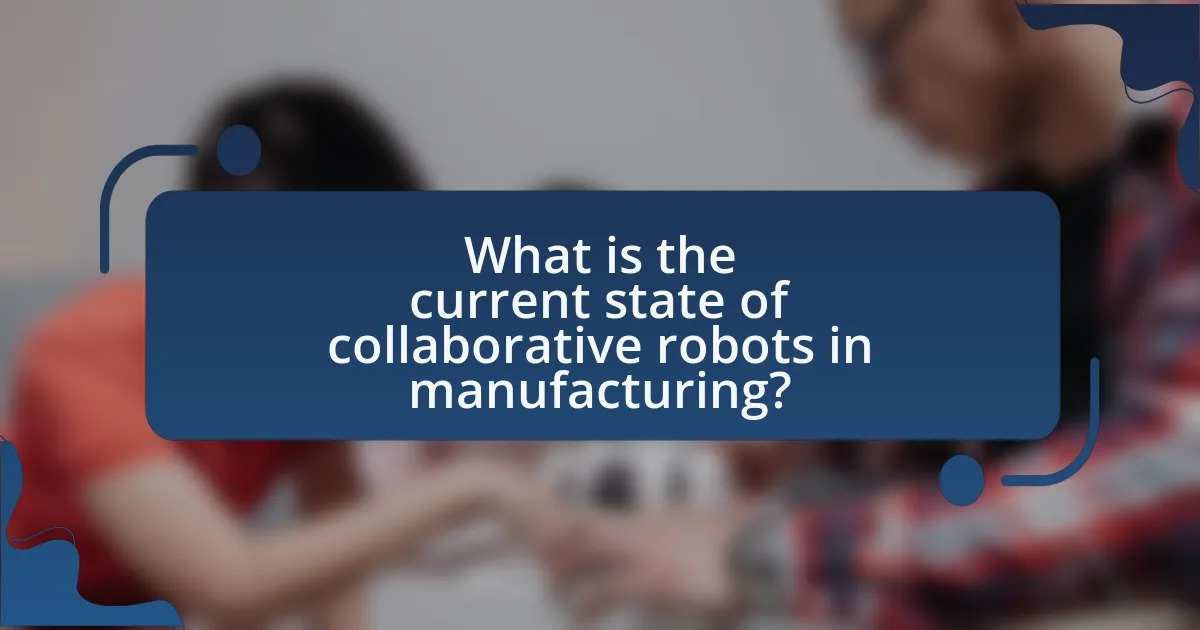
What is the current state of collaborative robots in manufacturing?
The current state of collaborative robots in manufacturing is characterized by widespread adoption and integration into various production processes. Collaborative robots, or cobots, are designed to work alongside human operators, enhancing productivity and safety. According to a report by MarketsandMarkets, the global cobot market is projected to grow from $1.2 billion in 2020 to $7.5 billion by 2026, indicating a significant increase in demand. This growth is driven by advancements in technology, such as improved sensors and artificial intelligence, which enable cobots to perform complex tasks with precision. Additionally, industries such as automotive, electronics, and consumer goods are increasingly utilizing cobots for tasks like assembly, packaging, and quality inspection, demonstrating their versatility and effectiveness in enhancing operational efficiency.
How has the adoption of collaborative robots evolved over the past decade?
The adoption of collaborative robots has significantly increased over the past decade, driven by advancements in technology and growing demand for automation in various industries. In 2013, the global market for collaborative robots was valued at approximately $100 million, and by 2022, it surged to around $1.2 billion, reflecting a compound annual growth rate of over 40%. This growth is attributed to the robots’ ability to work alongside humans safely, enhancing productivity and efficiency in manufacturing processes. Additionally, the rise of Industry 4.0 and the integration of artificial intelligence have further accelerated the deployment of collaborative robots, making them more accessible and versatile for small and medium-sized enterprises.
What technological advancements have driven the growth of collaborative robots?
Technological advancements such as improved sensors, artificial intelligence, and machine learning have driven the growth of collaborative robots. Enhanced sensors enable robots to perceive their environment more accurately, allowing for safer interactions with human workers. Artificial intelligence and machine learning algorithms facilitate adaptive learning, enabling robots to optimize their tasks and improve efficiency over time. According to a report by the International Federation of Robotics, the global market for collaborative robots is expected to grow significantly, driven by these advancements, with a projected increase in shipments from 30,000 units in 2018 to over 400,000 units by 2025.
What challenges have manufacturers faced in implementing collaborative robots?
Manufacturers have faced several challenges in implementing collaborative robots, primarily including safety concerns, integration complexities, and workforce acceptance. Safety concerns arise from the need to ensure that collaborative robots can operate alongside human workers without causing accidents, which requires rigorous safety standards and protocols. Integration complexities involve the technical challenges of incorporating collaborative robots into existing manufacturing systems, including compatibility with legacy equipment and software. Workforce acceptance is another significant challenge, as employees may resist the introduction of robots due to fears of job displacement or a lack of understanding of how these robots can enhance their work. These challenges highlight the need for careful planning and training to facilitate successful implementation.
What are the key benefits of integrating collaborative robots into manufacturing processes?
Integrating collaborative robots into manufacturing processes enhances productivity, flexibility, and safety. Collaborative robots, or cobots, work alongside human operators, allowing for the automation of repetitive tasks while enabling workers to focus on more complex activities. This integration can lead to a 20% increase in productivity, as reported by the International Federation of Robotics. Additionally, cobots can be easily reprogrammed for different tasks, providing manufacturers with the flexibility to adapt to changing production needs. Safety is also improved, as cobots are designed to operate in close proximity to humans without the need for safety cages, reducing workplace accidents and injuries.
How do collaborative robots improve operational efficiency?
Collaborative robots improve operational efficiency by automating repetitive tasks and enhancing human-robot collaboration. These robots can work alongside human operators, taking over mundane activities such as assembly, packaging, and quality inspection, which allows human workers to focus on more complex and value-added tasks. According to a study by the International Federation of Robotics, companies that implement collaborative robots can increase productivity by up to 30% while reducing operational costs by approximately 20%. This efficiency gain is attributed to the robots’ ability to operate continuously without fatigue, leading to higher throughput and reduced cycle times in manufacturing processes.
What cost savings can be achieved through the use of collaborative robots?
Collaborative robots can achieve cost savings by reducing labor costs, increasing productivity, and minimizing errors. These robots typically have lower operational costs compared to traditional industrial robots, as they can work alongside human workers without the need for extensive safety measures or dedicated workspaces. For instance, a study by the International Federation of Robotics found that companies implementing collaborative robots reported a 30% increase in productivity and a 20% reduction in labor costs. Additionally, the precision of collaborative robots leads to fewer mistakes, which translates to lower material waste and reduced rework expenses.
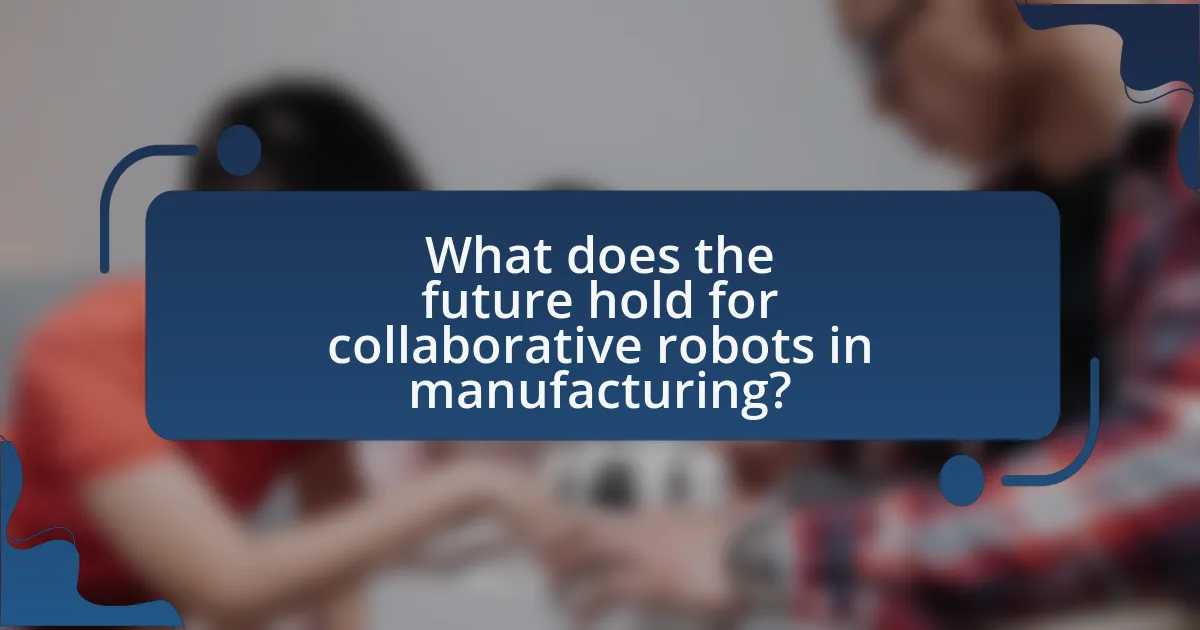
What does the future hold for collaborative robots in manufacturing?
The future of collaborative robots in manufacturing is poised for significant growth and integration into various production processes. As industries increasingly adopt automation, collaborative robots, or cobots, will enhance efficiency by working alongside human operators, improving productivity and safety. According to a report by MarketsandMarkets, the collaborative robot market is expected to reach $12.3 billion by 2025, growing at a compound annual growth rate (CAGR) of 41.5% from 2020. This growth is driven by advancements in artificial intelligence, machine learning, and sensor technology, enabling cobots to perform complex tasks with greater precision and adaptability. Furthermore, the increasing demand for flexible manufacturing solutions will lead to wider adoption of cobots, allowing manufacturers to quickly adjust to changing production needs while maintaining high-quality standards.
How will advancements in AI and machine learning impact collaborative robots?
Advancements in AI and machine learning will significantly enhance the capabilities of collaborative robots by enabling them to learn from their environments and improve their interactions with human workers. These technologies will allow collaborative robots to adapt to varying tasks and optimize their performance in real-time, leading to increased efficiency and productivity in manufacturing settings. For instance, AI algorithms can analyze data from sensors to predict maintenance needs, reducing downtime and improving operational reliability. Furthermore, machine learning can facilitate better human-robot collaboration by enabling robots to understand and anticipate human actions, thereby enhancing safety and workflow integration.
What new capabilities can we expect from future collaborative robots?
Future collaborative robots are expected to exhibit enhanced adaptability, improved sensory perception, and advanced human-robot interaction capabilities. These robots will utilize machine learning algorithms to adapt to varying tasks and environments, allowing them to work alongside humans more efficiently. Additionally, advancements in sensor technology will enable robots to better perceive their surroundings, facilitating safer and more precise operations. For instance, the integration of artificial intelligence will allow collaborative robots to understand and respond to human gestures and commands, significantly improving their usability in manufacturing settings.
How will the role of human workers change alongside the rise of collaborative robots?
The role of human workers will evolve to focus more on oversight, complex problem-solving, and collaboration with collaborative robots. As these robots take over repetitive and physically demanding tasks, human workers will shift towards roles that require critical thinking, creativity, and interpersonal skills. For instance, a study by the McKinsey Global Institute indicates that by 2030, up to 30% of tasks in manufacturing could be automated, leading to a demand for workers who can manage and maintain these robotic systems. This transition will necessitate upskilling and reskilling of the workforce to adapt to new technologies and workflows, emphasizing the importance of human-robot collaboration in enhancing productivity and innovation in manufacturing environments.
What trends are shaping the future of collaborative robots in manufacturing?
The future of collaborative robots in manufacturing is being shaped by trends such as increased automation, enhanced human-robot collaboration, and advancements in artificial intelligence. Increased automation is driving manufacturers to integrate collaborative robots, or cobots, to streamline processes and improve efficiency. Enhanced human-robot collaboration is evident as cobots are designed to work alongside human workers, ensuring safety and productivity through intuitive interfaces and adaptive learning capabilities. Advancements in artificial intelligence enable cobots to learn from their environments and improve their performance over time, making them more versatile and effective in various manufacturing tasks. According to a report by the International Federation of Robotics, the global market for collaborative robots is expected to grow significantly, indicating a strong trend towards their adoption in manufacturing settings.
How is the demand for customization influencing collaborative robot design?
The demand for customization is significantly influencing collaborative robot design by driving manufacturers to create more adaptable and versatile robotic systems. As industries increasingly seek tailored solutions to meet specific operational needs, collaborative robots are being designed with modular components and flexible programming capabilities. This trend is supported by the fact that 70% of manufacturers report a need for robots that can easily be reconfigured for different tasks, highlighting the shift towards personalized automation solutions. Consequently, collaborative robots are evolving to incorporate user-friendly interfaces and advanced sensors, enabling them to work alongside human operators in diverse environments while accommodating unique production requirements.
What role will collaborative robots play in sustainable manufacturing practices?
Collaborative robots will significantly enhance sustainable manufacturing practices by optimizing resource efficiency and reducing waste. These robots can work alongside human operators, performing repetitive tasks with precision, which minimizes errors and material waste. For instance, a study by the International Federation of Robotics indicates that integrating collaborative robots can lead to a 30% reduction in energy consumption during production processes. Additionally, their ability to adapt to various tasks allows manufacturers to implement more flexible production lines, reducing the need for excess inventory and further contributing to sustainability goals.
What best practices should manufacturers follow when implementing collaborative robots?
Manufacturers should prioritize safety, training, and integration when implementing collaborative robots. Ensuring safety involves conducting thorough risk assessments and adhering to safety standards such as ISO 10218, which outlines safety requirements for industrial robots. Training employees on how to work alongside collaborative robots is crucial, as it enhances productivity and reduces the likelihood of accidents. Additionally, integrating collaborative robots into existing workflows requires careful planning and consideration of the specific tasks they will perform, ensuring they complement human workers rather than replace them. Research indicates that companies that follow these best practices experience a 20% increase in productivity and a significant reduction in workplace injuries.
How can companies ensure a smooth integration of collaborative robots into their workflows?
Companies can ensure a smooth integration of collaborative robots into their workflows by conducting thorough assessments of existing processes and identifying specific tasks that can be enhanced by automation. This involves engaging employees in the planning phase to gather insights on workflow challenges and potential improvements, which fosters acceptance and collaboration. Additionally, providing comprehensive training for staff on how to work alongside robots is crucial, as it enhances safety and operational efficiency. Research indicates that organizations that prioritize employee involvement and training experience a 30% increase in productivity when integrating collaborative robots, demonstrating the effectiveness of these strategies.
What training is necessary for workers to effectively collaborate with robots?
Workers need training in robotics operation, safety protocols, and teamwork dynamics to effectively collaborate with robots. This training should include hands-on experience with robotic systems, understanding their capabilities and limitations, and learning how to communicate and coordinate tasks with robotic counterparts. Research indicates that effective collaboration between humans and robots enhances productivity and safety in manufacturing environments, as evidenced by studies showing a 20% increase in efficiency when workers are trained to work alongside collaborative robots.
